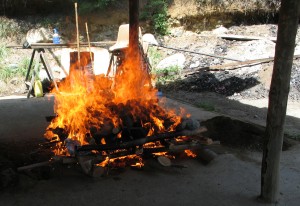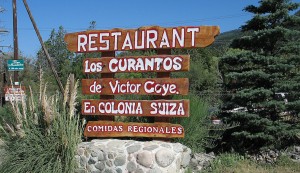We arrived at the “Curanto de Victor Goye” around 11:00 and the fire was already roaring and crackling. The cooking stones were getting hot. Tubs of vegetables were set out on the bench next to the fire. But the meat had been kept back until time to start the cooking.
There were tubs of potatoes, onions, apples, carrots and sweet potatoes. But most interesting were two large round squashes about 10-12 inches in diameter.
The top had been carefully carved off and the seeds removed. Then a mixture of peas, cheese and other vegetables with slices of tomatoes on the top. These would nestled into the hot rocks and slowly cooked with the rest of the vegetables and meat.
Guests continued to arrive as the fire burned down. Eventually the announcement came that the stones were hot and the food would be put into the pit for cooking. All the guests gathered to watch. Extraneous coals were removed, the concrete surrounding the pit was hosed down and swept clean. Only hot rocks were left in the pit – no glowing embers. A large tub of meat was brought out and the vegetable tubs were placed close to the pit. The two large squashes were nestled into the stones. Then specially gathered leaves that are available only during certain months of the year were placed around the squash and over the hot stones. I don’t have pictures of this part of the process – I was taking videos which I will edit when I get home.
Meat was placed on the leaves: chicken halves, lamb, pork, chorizo (sausages) and beef. The tubs of vegetables were dumped onto the leaves and everything leveled out. Then another layer of leaves was placed over all the food and a couple layers of burlap were placed over the leaves. Finally, dirt was shoveled onto the burlap and the cooking was begun. During all this preparation, we were served a yerba tea and a piece of ‘pan frito’ (fried bread).
After the food was all put into the ground, Victor Goye, the owner and host, told the history of the curanto. It originated in Polynesia. I added that it is very common as a ‘Hungi’ in New Zealand. In Chile, it is a way to cook ‘mariscos’ (sea food). When it came over the Andes to Argentina, the seafood was replaced with meat.
The cooking would take around 2 1/2 hours. It was now time to gather for the ceremony which would be held in front of the dining hall.
Victor Goye’s dining hall is a work of art. It is all wood – mostly cypress – and whole logs are incorporated into the structure.
Here is a video of the curanto preparation.




